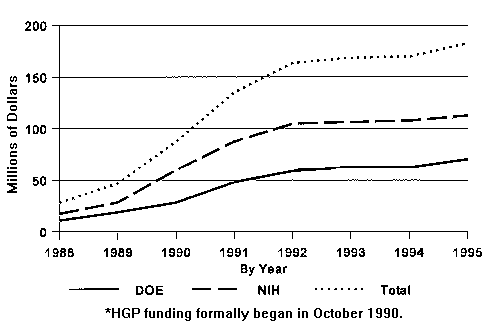Archive Site Provided for Historical Purposes

Sponsored by the U.S. Department of Energy Human Genome Program
Human Genome News, September-December 1995; 7(3-4):1
Project History, Progress, Challenges, and Impact Highlighted in This Issue
October 1 marked the fifth anniversary of the Human Genome Project in the United States. This issue of HGN provides an overview of progress toward the initial short-term goals set out by NIH and DOE in October 1990 and the long-term goal of developing scientific resources and technologies for the DNA-based biology of the 21st century. Impressive progress has been made in all targeted areas: genetic and physical mapping of the human genome; DNA sequencing; analysis of the genomes of several important nonhuman organisms; informatics; resource and technology development; and ethical, legal, and social implications (ELSI) of genetic research for individuals and society. In 1993, 3 years into the project, advances in technology allowed the original 5-year goals to be updated with more-ambitious approaches. However, a broad range of technological advances is still needed to achieve extended goals by 1998 and also to reach the ultimate objectives the complete sequence of the 3 billion human DNA base pairs and identification of all human genes by 2005.
Advances in genome research have come about through the efforts of a large number of investigators in the United States and abroad. The U.S. Human Genome Project is supported by NIH and DOE at 22 specialized human genome research centers and in many university, national, and private sector laboratories. At least 14 other countries now have programs for analyzing the genomes of a variety of organisms ranging from microbes to economically important plants and animals to humans. A remarkable spirit of cooperation has facilitated human genome research around the world.
One purpose of the Human Genome Project is to provide new "infrastructure," including data and material resources and technology that will improve the ability of investigators to do biological research rapidly, efficiently, and cost-effectively. To achieve this purpose, the accomplishments of genome researchers must be easily accessible. Guidelines describing reasonable sharing practices were developed by advisors to NIH and DOE in 1992, and the genome research community has responded admirably. Information sharing and services have been facilitated by the physics community's gift of WWW protocols, which have greatly simplified data presentation and transfer across the Internet. Additionally, materials and reagents produced by genome research investigators have been made widely available, often through commercial sources.
As the scientific community hoped, the genome infrastructure has rapidly accelerated the study of inherited human disease. A wide range of other genome-research applications also indicates that the promise of the genome project is being realized. In this issue, David Smith (DOE) and Francis Collins (NIH), Directors of the U.S. Human Genome Project, offer their perspectives on goals, benefits, and challenges of the project. Also included in this issue is a summary of research highlights.

Human Genome Project Funding. As recommended in reports by NRC and DOE HERAC, the original goals assumed a funding level of $200 million annually, adjusted for inflation. This funding level has not yet been achieved.
Return to the Table of Contents
The electronic form of the newsletter may be cited in the following style:
Human Genome Program, U.S. Department of Energy, Human Genome News (v7n3).
The Human Genome Project (HGP) was an international 13-year effort, 1990 to 2003. Primary goals were to discover the complete set of human genes and make them accessible for further biological study, and determine the complete sequence of DNA bases in the human genome. See Timeline for more HGP history.
Published from 1989 until 2002, this newsletter facilitated HGP communication, helped prevent duplication of research effort, and informed persons interested in genome research.